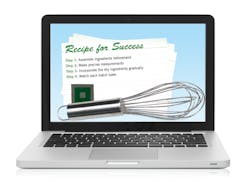4 steps to integrating vending technology
Over the last decade, technological innovations have led to a movement to modernize the vending industry. Some companies have made significant advancements in efficiency and productivity by incorporating technology into their daily operations, while others have seen little realization of technology’s benefits. Implementation headaches for office staff, technicians, and route drivers have limited the potential returns of many promising devices. If item level data collection, pre-kitting, telemetry and other computer assisted solutions are critical to the survival of operators, how can the challenges of implementation be overcome?
During my tenure as operations manager for Monumental Vending in Beltsville, M.D., I oversaw the integration of many such devices and systems. As we adapted to each new innovation, I began to notice how the operation’s implementation strategy mirrored, of all things, the method for baking cookies. Successful technology integration, and better baking, are both achieved by following the same set of rules. Whether setting up a pre-kitting system or making Heath toffee chip cookies (they are SO good!) success can be expected when following four simple steps.
1. Assemble ingredients beforehand.
Similar to how cookie baking requires both wet and dry ingredients, implementing technology into a vending operator requires different components. The wet ingredients in the vending scenario are the people trying to communicate with the new device or system.
The dry ingredients are the devices and systems themselves. Examples of dry ingredients are: handhelds, VMS/pre-packing systems, telemetry units, material handling devices, and workstations.
Visualization of the finished product is also important, so everyone knows success when they see it. Senior management should decide what integrations go along with the overall goals of the company and paint as clear a picture as possible of the desired results.
It is vitally important to gather all of the ingredients before beginning the process. Assembling both the people and hardware beforehand will save time and limit frustration when starting to install the systems. Selecting the right people from each department (route drivers, technicians, office staff, etc.) who will be spearheading the integration is critical for smooth integration. Let them know what success will look like and get their buy-in for completion. All the various components of technology (handhelds, telemetry units, VMS, etc.) require human beings to install, activate, build and maintain them. People make technology perform. The right group of leaders with the right set of goals will produce the longest lasting positive change. Talk to equipment and system suppliers to be sure you can procure enough hardware. Purchase material handling supplies beforehand so you have what you need to expand quickly. Nothing slows down pre-kitting faster than running out of totes.
2. Make precise measurements
Much like ordinary cooking, day-to-day vending operations can often get by with a fair amount of improvisation. However, just like baking, data driven efficiency improvements require a much more precise approach. Good results in baking and successful technology integration both require accurate measurement. The phrase, “garbage in, garbage out” is quite applicable here. Computers can only regurgitate what they have been given. In baking, the exact proportions of sugar, fat and leavening agent play a big role in the finished products’ presentation, taste and texture. Similarly for vending, the pre-kit lists, returns and product selections rely on accurate line-item data.
3. Incorporate the dry ingredients one third at a time
Adding the dry ingredients to the wet ingredients all at once doesn’t make a very good cookie batter. It’s better to mix the components together a little at a time. In my experience, this is a good tactic to employ when adding any new piece of technology to an operation as well. Make the new device or system work on one route first, before expanding it any further. This gives the company time to start adjusting to change and gives the project a greater chance for success. Once the device or system is stable on the first route, expand the project out to three. Once the group of three routes shows it can function properly, move it out to the rest of the company as quickly as time and resources permit.
4. Watch each batch closely as it bakes
Knowledge acquired from data is incredibly powerful and can bring about significant changes in human behavior. When the White family bakes, we pay special attention to each batch as it transforms in the oven from dough to cookie. The lessons we learn from the first batch makes subsequent batches better. The same is true when churning out technology improvements. Pay close attention to the data as it begins to accumulate. Is it accurate? Are the calculations correct? What are we learning that we never knew before? Pay equally close attention to the staff leading the project. Are their questions being answered? Are they getting the support they need? Who can they turn to when problems arise? Lessons learned from the initial integration will help tremendously with subsequent integrations.
The finished product
For my family, the fruits of our efforts can be enjoyed almost immediately. Incorporating technology throughout the organization takes a little bit more time! However, the finished product is well worth the effort. New innovations and increased regulation continue to transform our industry. The time to perfect a recipe for adapting and profiting from these changes is now. I am looking forward to the future of automated retail. Incorporating technology will bring significant advantages to every organization that embraces a positive culture of change.
